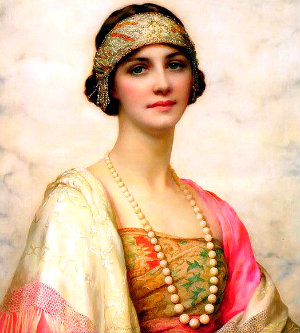| home | medieval art | artist quotations | iconography | 100 greatest paintings |
| renaissance art | artist biographies | top 50 painters | rococo art | book store |
William Clarke Wontner
1857-1930
British Academic Classicists Painter
Stylistically influenced by the following painters - Jean Leon Geromer, Paul Delaroche, and Thomas Couture
Cause of Death - Old Age

Description of William Clarke Wontner Academic Classicism Style
Academicism is the painting style established by European art academies and universities. In general It is also called "academic art". In this context as new styles are embraced by academics, the new styles come to be considered academic, thus what was at one time a rebellion against academic art becomes academic art. The academic art world also worshiped Raphael, for the splendor of his work. This style is often termed "art pompier", "academism", "academicism", "classical revival", "beaux-arts classicism" and "eclecticism".
The followers of Academicism appreciated and imitated Greek and Roman literature, art, and architecture. This style stems from Neoclassicism, but with a distinctly original elegance. Academicism differs from Neoclassicism in subject matter as well.
Followers of this movement were influenced by the high standards of the
French Académie des Beaux-Arts, which practiced under the movements of Neoclassicism
and
Romanticism.
Academicism attempted to merge both techniques to create the perfect
style. It is characterized by adhering to a strict manner of painting,
following narrow compositional rules and delicacy of color. This
opulent style is rich in textures and qualities.
According to art historian, Walter Pater "To produce such effects at
all requires all the resources of painting, with its power of indirect
expression, of subordinate but significant detail, its atmosphere, its
foregrounds and backgrounds."
About the Artist
Wontner preferred lighthearted subjects and motifs derived from classical love stories and mythological themes. His style favored playful interpretations of Greek, Roman and Renaissance narratives. He had an extraordinary way of capturing nature's tempestuous, "biological" qualities and yet, at the same time, create in the viewer an almost spiritual reaction of harmony and serenity. His brushstrokes were graceful, dramatic and spontaneous, depicting a world of magnificent splendor.
Related Artists
Ivan Konstantinovich Aivazovsky, 1817-1900
Adolphe-William Bouguereau1825-1905
Charles Emile August Carolus-Duran, 1837-1917
Leon Francois Comerre, 1850-1916
Pierre-Auguste Cot 1837-1883
Thomas Couture, 1815-1879
Paul Delaroche 1797-1856
Eugene Fromentin, 1820-1876
Jean Leon Gerome, 1824-1904
Jean-Paul Laurens1838-1921
Adolphe Alexandre Lesrel, 1839-1929
Luc Olivier Merson, 1846-1920
Hans Makart, 1840 - 1884
Giulio Rosati, 1858-1917
Franz Xavier Winterhalter, 1805-1873
William Clarke Wontner, 1857-1930
Fritz Zuber-Buhler, 1822-1896
Require more information about William Clarke Wontner? Type
your query in art into the google search box below and poke around
every nook and cranny of the known universe for information this
subject.
© HistoryofPainters.com If you like this page and wish to share it, you are welcome to link to it, with our thanks.
If you feel you have worthwhile information you would like to contribute we would love to hear from you. We collect essential biographical information and artist quotes from folks all over the globe and appreciate your participation. When submitting please, if possible, site the source and provide English translation. Email to millardmulch@gmail.com